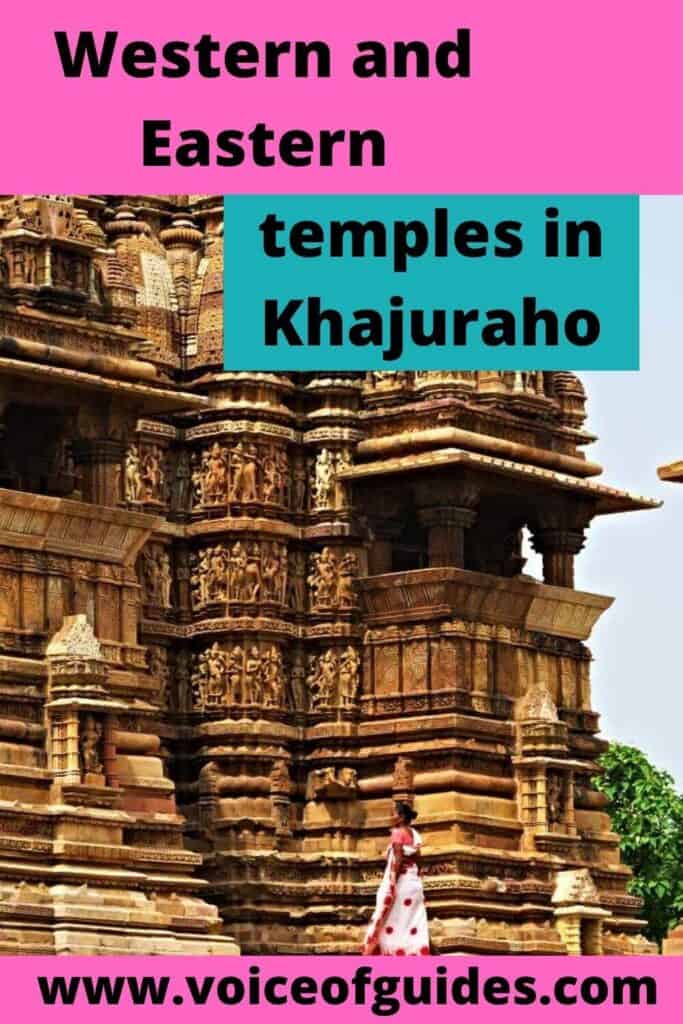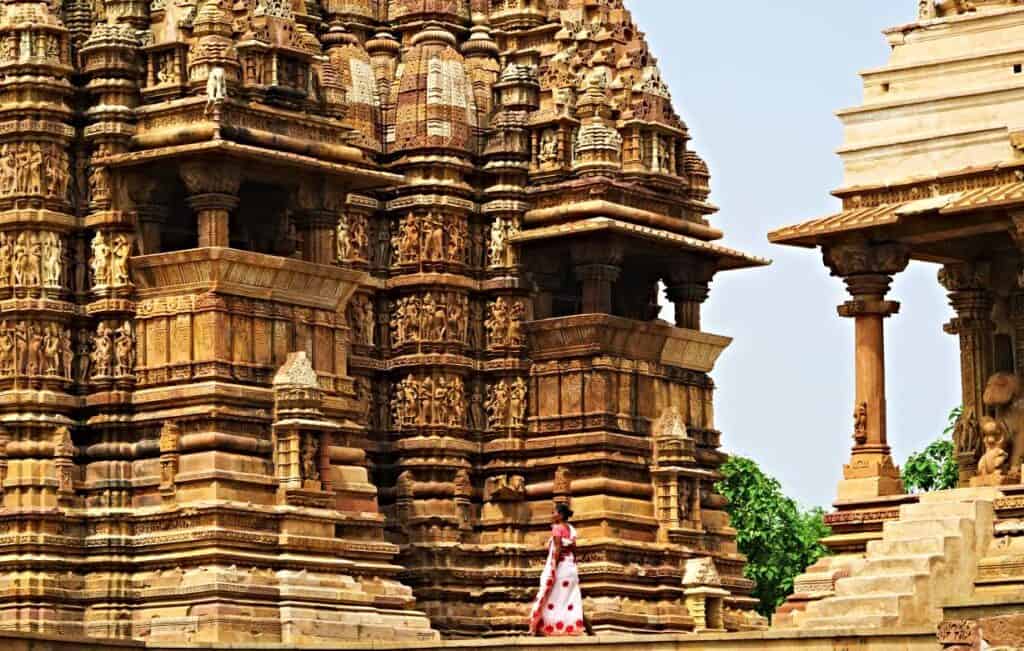The temples in Khajuraho are mainly famous for their erotic sculptures, although these make up only 10% of all the carvings. Even in the 20th century, many Indians insisted on destroying the temples due to their shameful decoration. Gandhi was also among the supporters. Tagore, a Nobel laureate in literature, disclosed in a letter to Gandhi that these monuments are of national importance and must be preserved.
Khajuraho is a perfect destination to extend your Golden Triangle itinerary.
The history of the Khajuraho temples
The historically not so remarkable Chandela dynasty built 85 temples in the 10th-11th century, out of which 25 still exist. Remarkably, within only 200 years, such masterpieces were erected that served as an example for the North-Indian temple architecture for several centuries. Apart from the Matangeshvara temple, the rest is not in use anymore.
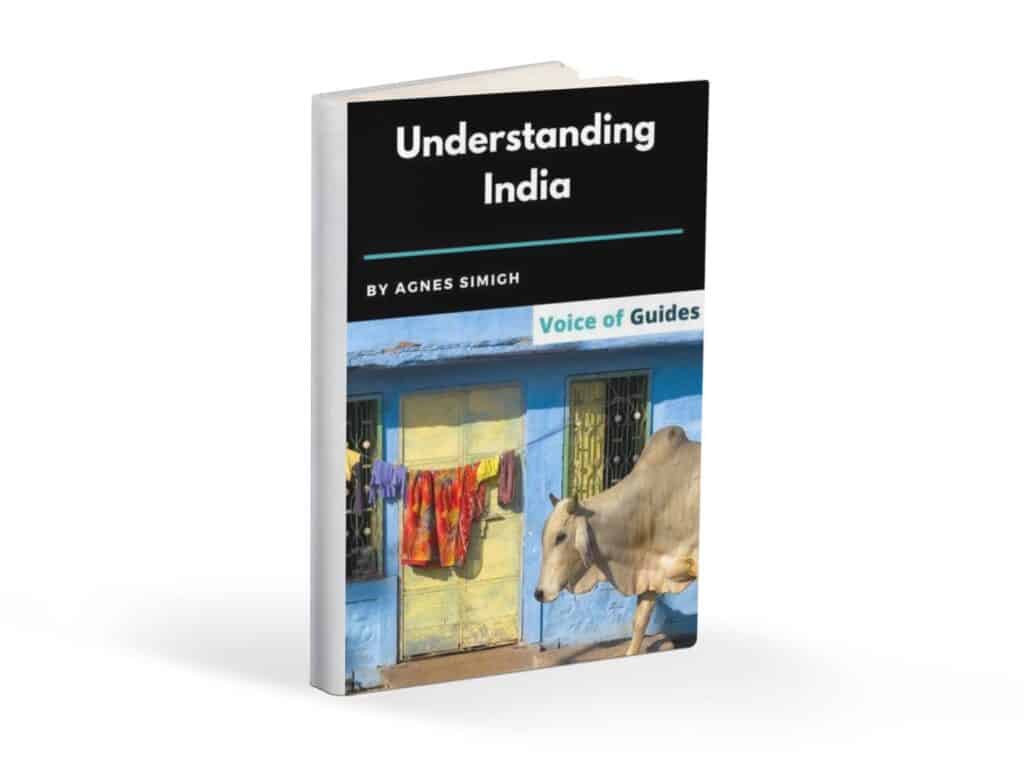
The temples are a sign of the richness and abundance of India during the reign of the Candelas. They were not only a place of worship. Locals used them for social encounters and assemblies. Khajuraho was abandoned when Islam started to spread in the 13th century, and the Sultans of Delhi expelled the Chandela dynasty. The Muslim rulers hardly made use of the temples, and the jungle absorbed them. Once the British discovered the ruins amid the lush greenery in 1840, they started large-scale excavations.
There are three geographical groups of temples in Khajuraho:
- The western (around the hotel area)
- The eastern (close to Khajuraho village)
- The southern (near the airport)
The easiest way to get there is to take an auto-rickshaw from one complex to the other. The distance is just a few kilometers.
Most temples are part of the western group, including the largest (Kandarya Mahadeva) and the oldest temple (Chausath Yogini).
The Eastern group contains three actively used Jain temples. They make Khajuraho one of the most significant Jain religious places in India. Visitors often skip the southern group that only has two temples and is not easy to reach.
The temples in Khajuraho are scattered in an open space without a wall. They stand on a platform that protects them from the monsoon rain and the animals. Some of them have four shrines at each corner. Most of the temples were built from sandstone and look east, where the sun rises. The shapes of the temples recall the towering peaks of the Himalayas and consist of the following elements:
- An entrance porch (ardha-mandapa),
- a small hall (mandapa),
- a large hall (maha-mandapa),
- a vestibule (antarala)
- a sanctum (garbhagriha) with a roof tower (shikhara).
How can you get to the temples in Khajuraho?
Flight: Khajuraho is a small town with 24 000 inhabitants. But due to its magnificent temples, a modern airport welcomes the visitors. There is a direct flight from Delhi and Varanasi to Khajuraho.
Train: There is a daily train to Delhi via Mahoba, Jhansi, and Gwalior. It has a daily connection with Jaipur, Udaipur, Bhopal, and Agra. A train goes to Varanasi three times a week.
By Road: Khajuraho has a road connection to every major city nearby. But the road is very bumpy and makes it a long ride. It is still a better option to take a private car instead of a bus.
What is the best time to go to Khajuraho?
The best time to come to Khajuraho is between October and March. The rest of the time gets too hot, which is not very pleasant when you spend hours visiting temples. The monsoon time (June-September) is also not ideal for a visit.
Tip: It is a place where I highly recommend hiring a guide to visit the temples. He can show you the exciting details and help you understand the mythological stories behind the reliefs. Without his expertise, you walk around without understanding the real meaning of these 1000-year-old temple decorations. And all Khajuraho is about the temples.
Opening hours, entrance fee, sound & light show of the Western temples
Opening hours of the Khajuraho temples: from sunrise to sunset
Entrance fee: Eastern complex: free of cost, Western complex:
5:00 AM – 12:00 PM
4:00 PM – 9:00 PM
Sound & light show
A spectacular 50 minutes-long sound and light show takes place every evening in the Western group of temples in English and Hindi narrated by the Bollywood film icon, Amitabh Bachan. Visitors get information about the history, architecture, and art of the Khajuraho temples. The illuminated temples look stunning at night.
Entrance fee: For Indians 250 INR, for foreigners 700 INR
Showtime
From October to February: 6:30 pm (English), 7:40 pm (Hindi)
From March to September: 7:30 pm (English), 8:40 pm (Hindi)
Why do the Khajuraho temple sculptures display erotic scenes?
The Khajuraho temples are famous for their sexual-themed statues and carvings but are not the only ones in India. The Sun Temple Konark in Odisha also displays scenes from the Kamasutra, although not in such a volume as Khajuraho. Kama is the God of love in Hindu mythology. His holy book, the Sutra, exposes all the positions and technics of sexuality, which come to life in the temple decorations.
The best two-week itinerary including the Golden Triangle
It is not clear why they carved erotic scenes on the temples. There are only assumptions.
Some say that the Chandela dynasty followed the tantric tradition. They believed that accomplishing worldly desires entail spiritual awakening.
Others say that the erotic carvings had an educative purpose for those being influenced by Buddhism and get the young boys ready for the married life.
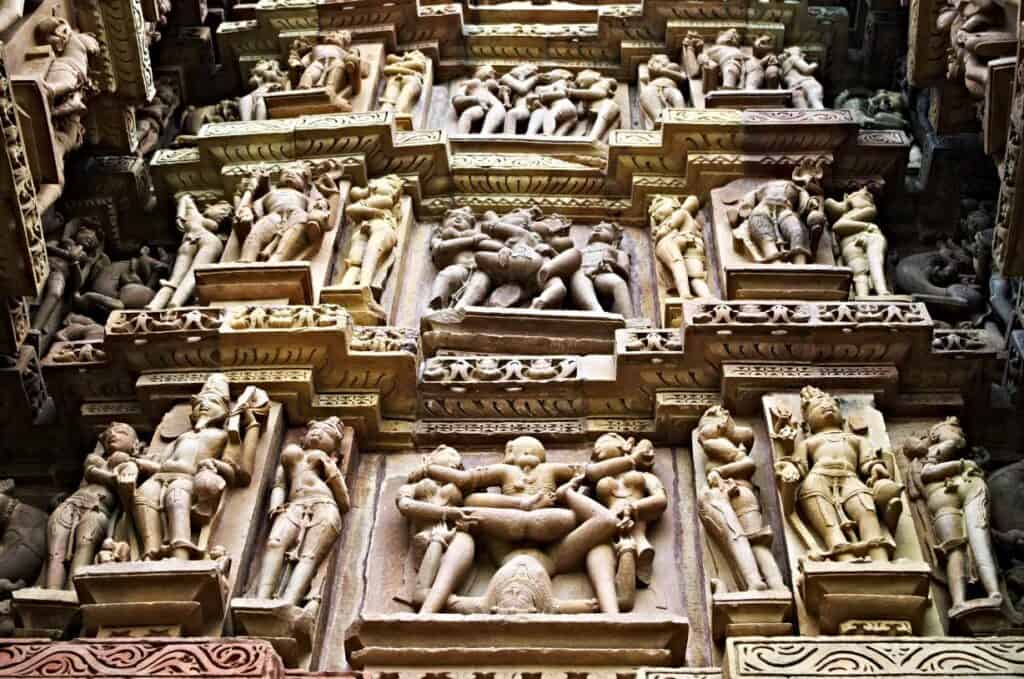
The Chandelas trace their origins to the moon. According to the legend, Chandravarman, the son of the moon founded Khajuraho. Hemwati was a beautiful woman who became a widow when she was only 16. The God of the moon got attracted to her and descended to earth. After a night they spent together, Hemwati became angry with God for seducing her. Chandra, the Moon-god promised her that their son, Chandravarman would become a powerful king. Her mother raised him in the forest, far from the malignant residents. As anticipated, he founded the Chandra dynasty that ruled Middle-India in the 9th-12th century. His mother asked him in his dream to build temples that depict human salacity and sexuality.
According to another explanation, the erotic scenes were to keep the devil away.
It is also possible that the complex of Khajuraho is nothing else than a celebration of love, emotions, and harmony.
The Kandariya Mahadéva, the Lakshmana, and the Chitragupta temples have most of these decorations, but just on the exterior. Once the devotee gets inside, nothing should divert his attention from worshipping God. Some temples completely lack the sexual decorations that Khajuraho is so famous for.
They estimate that 20.000 statues decorate the temples. Apart from the erotic scenes, the carvings depict Hindu Gods and Goddesses, wild animals, servants and scenes of daily life.
You can see as the children go to school, the workers carry pieces of stones, the musicians play the drum, the women put on some make-up, washing their hair, or remove thorns from their feet. Doctors operate, the elderly people gossip, actors entertain the audience, soldiers combat in the war with elephants, horses, camels, or on foot.
Vishnu, Shiva, Surya (God of Sun), nymphs (dancers who entertain the Gods in heaven) are all displayed.
The most stunning about these statues is that the scenes are so realistic that you feel like being in a gallery and watch daily activities and emotions. There is pain, sorrow, happiness, desire, satisfaction, and disappointment on the faces.
Unarguably, females are much more dominant. Here men play only a secondary role. Women are the center of countless activities. You can see the women writing love letters or preparing their partners for sexual intercourse. The female forms and facial expressions are way more enhanced. They show up as powerful, self-confident human beings full of energy.
Due to the incredible number of statues, go around clockwise like Hindus, and focus on the meticulous carvings.
The Eastern group of temples
The eastern group of temples is located closer to the village with three Hindu and four Jain temples, proof that the two religions could peacefully coexist. The Jain temples are active places of worship. Here you can encounter the devotees from the most ascetic religion in the world.
1. Hindu temples in the Eastern group
Statue of Hanuman
Halfway from the Western group to the Eastern group stands the 2.5-meter-high red colored statue of the Monkey God, Hanuman.
Vamana Temple
The Hindu temple was dedicated to the dwarf incarnation of Lord Vishnu, called Vamana. Apart from the different avatars of Vishnu, enchanting nymphs wearing jewelry and a nice coiffure decorate the temple.
Brahma temple
It is one of the oldest temples from around 900 AD. Originally it was dedicated to Vishnu as indicated on the lintel above the sanctum. But there is a Shiva lingam inside, which makes all that confusing. The idol in the sanctum was wrongly called Brahma. Even when they recognized the mistake they did not change it. The temple is on the banks of the Khajuraho Lake or Khajuraho Sagar.
Javari temple
Strangely, this temple does not carry the name of a Hindu God. Javari was probably the owner of the land. The Vishnu temple is one of the smallest but one of the most intricately carved temples in Khajuraho.
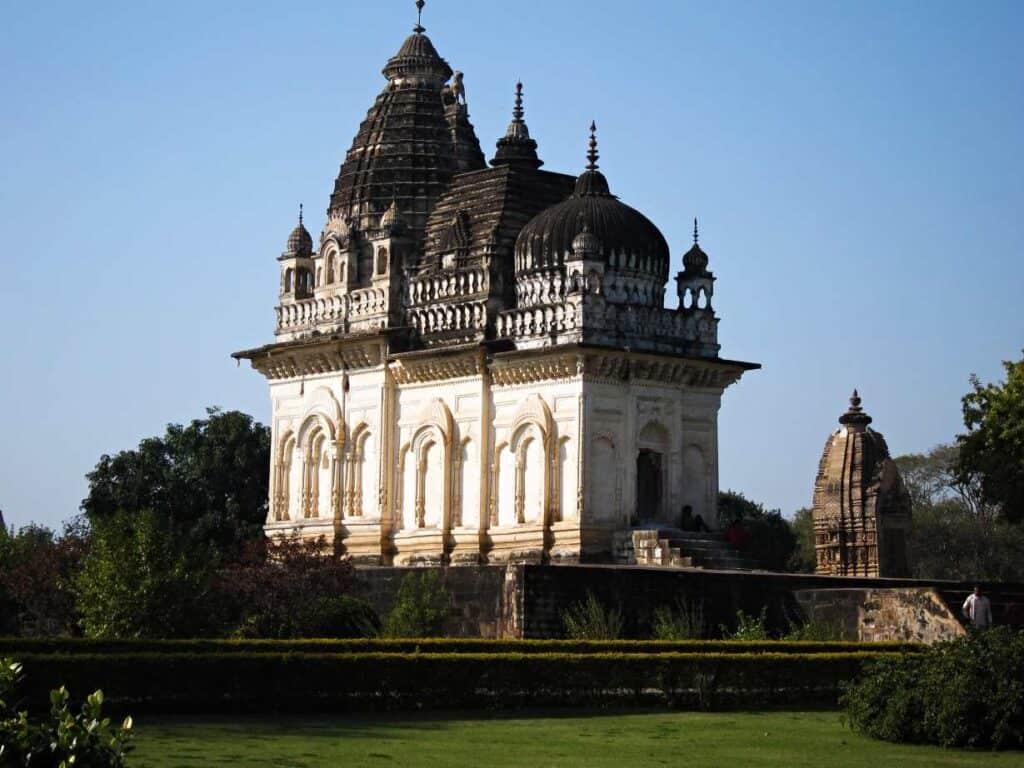
2. The Jain temples in the Eastern group
The Jain temples in the Eastern group are still active places of worship. It means that you can see Jain monks from the Digambar, „sky-clad” sect come to the temples. They live entirely naked to respect the life of all living creatures. They are afraid to harm some small insects stuck in the tissue if they wear clothes. Therefore, they shave their hair for the same reasons and sweep the road as they walk to avoid stepping on anything. Those who belong to the „white-clad” sect wear a simple white cloth wrapped around their body.
Jains make up less than 1% of the total Indian population, but their temples are famous for the impressive carvings in the interior. Since Mahavira and Buddha, the founders of Jainism and Buddhism were coevals, the two religions were born at the same time. Since then, Khajuraho has become a center of the Jain religion in India.
They pray to Tirthankaras, who are not respected as Gods but preach and instruct the people. Contrary to Hindu temples, the statues of Tirthankaras stand in the center of the Jain temples. They usually have emotionless faces.
Ghantai temple
Only an open colonnade is left from the original temple. There is a relief of Mahavira, the founder of the Jain religion. Ghanta means chain and bell and refers to the decoration of the columns.
Adinath temple
It is a smaller temple partly in ruins but famous for the extensive carvings of Yakshis (the female partners of the mythical nature spirits called Yakshas) and mythical lion-like and magical creatures. The Adinath temple is similar to the Vamana temple. Its plan and design hardly show any difference. Although it is a Jain temple, you can spot Hindu Gods on the outer surface. It is not unusual as Hinduism and Jainism are closely related. Jainism is probably the most ascetic branch of Hinduism.
Inside the temple, one statue shows Adinath, the Jain Tirthankara in a sitting position.
Parsvanatha temple
It is the most attractive Jain temple of Khajuraho with perfect architecture and beautiful statues and carvings. Parsvanatha is one of the 24 Jain Tirthankaras. On the outside walls, women turn up with children, flowers, or doing their make-up. First, it was dedicated to Adinath, but in 1860 they placed the modern black statue of Parsvanatha inside the temple. It is the manifestation of the highly qualified Indian craftsmanship of that era.
It is famous for its magic square (a mathematical puzzle) carved inside the site.
Santinatha temple
Shantinatha is a temple complex comprising numerous modern shrines. The temple complex was built about a century ago. But in many places, you can spot architecture and carvings that date to much earlier times. The main sanctuary houses an impressive 4.3 meter-high polished icon of Adinatha from the 11th century.
This temple does not preserve much from ancient times. It was constructed using the remains of several other temples. A 4.5-meter tall Adinath statue stands in the sanctum.
The Western group of temples
Chausath-Yogini temple – the oldest temple from the 9th century
Chausath means 64 and refers to the mythological story when Goddess Durga was manifested in the form of 64 yoginis to defeat the demon. It is the most undecorated and plain of all the structures, and contrary to the other fourteen circular Chausath-Yogini temples in India, it has a rectangular plan. It is also the only one that was built out of granite instead of sandstone. The central cell probably housed the statue of the deity, Durga. The other 64 around one meter high and one meter deep cells contained the statues of yoginis, but now only 35 remained intact.
The temple construction dates to the 9th century making it the oldest temple in the complex. It faces north-east, while the other shrines in the complex all face East, where the sun rises.
But it still becomes crowded during the Navatri festival, when they celebrate Goddess Durga. Local women place clay pots with sprouted millets around the central cell. Goddess Durga is one of the dreadful incarnations of the wife of Lord Shiva, Parvati. During the nine-night festival, they celebrate that Durga could defeat Mahishasur, the demon. Durga, the fearsome female warrior riding a lion, cut off the head of the demon. Celebrations take place at night when they finish the prayers and fasting.
Lakshmana temple
It was the first monumental construction of the Chandela dynasty in Khajuraho. The Lakshmana temple erects like a giant mountain in the middle. Confusingly, the temple bears the name of Lord Rama’s brother but is dedicated to Lord Vishnu under the name Vaikuntha. When it was built in the 10th century, it may have been the largest temple in North-India. Other Gods of the Hindu pantheon, Lakshmi, Brahma, Shiva, Vishnu and all his ten incarnations are also displayed among the statues. Above the entrance, a famous Hindu mythological scene depicts the churning of the ocean of milk, when the devas (gods) win over the asuras (demons) and regain the nectar of immortality (Amrit). Vishnu, the main deity, appears with three heads (human, lion and wild boar).
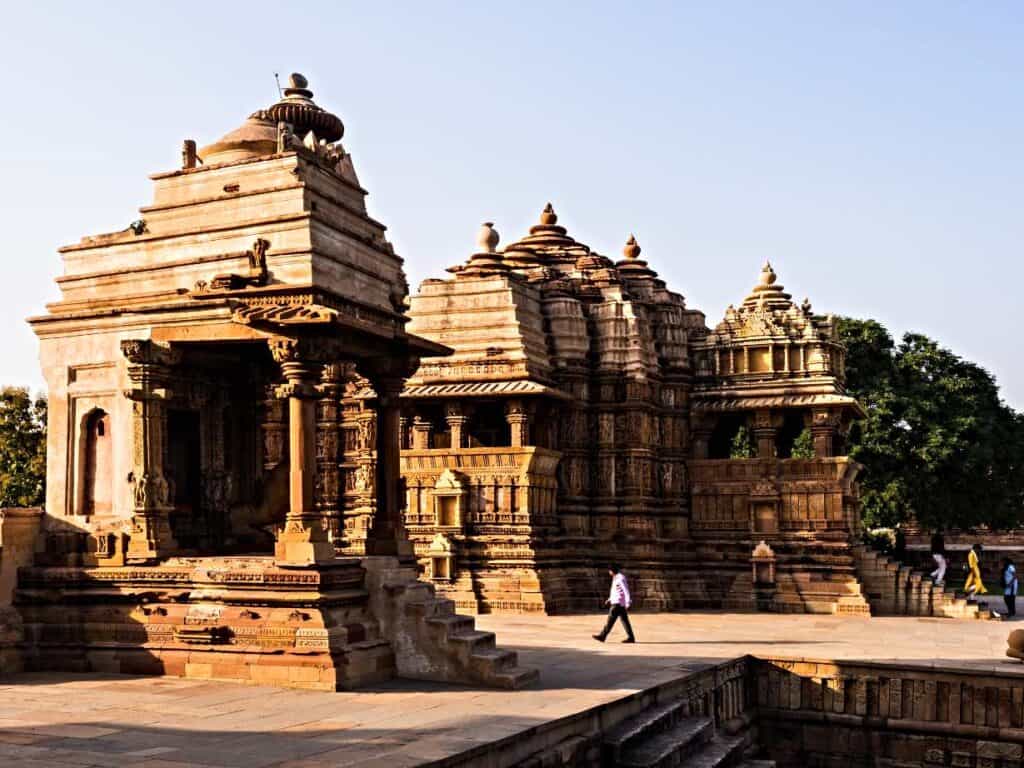
Kandariya Mahadeva – the largest temple of Khajuraho
Kandariya Mahadeva is the largest and most impressive temple of Khajuraho. Kandara means „cave”, Mahadeva is another name of Shiva, hence the name „The Great God of the Cave”. The temple resembles a towering mountain if you look at it from a distance and the side.
It is the symbol of Kailash Mountain. According to Hindu mythology, it is the abode of Shiva and his wife Parvati in the Himalayas. This temple followed the nearby Lakshmana temple at the beginning of the 11th century.
The 30 meter-long, 20 meter-wide temple stands on a three-meter-high platform. The lingam (symbol of Shiva) occupies the inner sanctum. The towering central spire (sikhara) also manifests the lingam, the phallus-like symbol of Shiva, but altogether 84 smaller spires decorate the top. Some say that almost 900 statues appear inside and outside, and many are one meter high.
It has become the most ornate temple of Khajuraho. If you go to the south side, you see loving couples with their arms and legs entwined in deep emotions. But at other places, acrobatic sexual scenes involving three or four participants also turn up.
Varaha temple
The main attraction is the giant statue of Varaha (2.6 meters long and 1.7 meters high), the boar incarnation of Shiva. The artists carved it out of a single block of sandstone. According to Hindu mythology, Vishnu was incarnated as a boar to save the goddess of earth from the demon, who dragged her to the sea bottom.
Matangesvara temple
The only active temple in the whole complex has a 2.5 meter-high lingam (the symbol of Lord Shiva) in the center. During religious ceremonies (pooja), the priests (brahmins) decorate the lingam with garlands and wash it with ghee (purified butter). Devotees come to worship God and make their offerings. Compared to the other temples, there are not many statues and carvings.
Tens of thousands of devotees celebrate here the Shivatri festival in February-March. They celebrate the marriage of Shiva with Parvati. They bathe the lingam and decorate it like a real bridegroom as part of the ceremonies.
Opening hours: 06:00 am to 06:00 pm every day.
Chitragupta temple
The two-meter tall statue of the Sun God (Surya) riding a chariot of seven horses is the main attraction of the shrine. The outside decoration displays couples in erotic positions, several Hindu Gods and apsaras (celestial singers and dancers). The carrier of Shiva, Nandi appears with a human body and a bull’s head.
Visvanath temple
Visvanath is another name of Shiva, meaning “The Lord of the Universe”. The massive sculpture of Nandi stands in front of the temple. It has a marble Shiva lingam as the main deity, and the three-headed Brahma statue stands in another shrine. The erotic scenes of these temples show quite shocking sexual interactions in groups.
Devi Jagdambi temple
The middle-size Devi Jagdambi is famous for its intricate artistic sculptures depicting Hindu Gods (Vishnu, Shiva, Brahma) and emotional scenes. Loving divine couples show affection and love towards each other. A beautiful woman gazes at herself in the mirror while her scarf lets her shoulder be exposed. In the sanctum, the giant statue of Parvati, wife of Shiva, catches the eye.
The Khajuraho dance festival
The classical dance festival of Khajuraho manifests the rich cultural tradition of the country. The illuminated Viswanath and the Chitragupta temples of the western group serve as a backdrop for the event.
They organize the festival since 1975 to celebrate Indian dance and music traditions. The one-week-long festival usually takes place in February or March. If you happen to be in Khajuraho at that time, you should not miss that. Dance and music play an essential role in Hinduism too. Shiva is the God of dance. Krishna played his flute and seduced hundreds of thousands of gopis (wife of the cowherds). The apsaras are dancing in heaven to entertain the Gods.
The Kathak, Bharathanatyam, Odissi, Kuchipudi, Manipuri, and Kathakali dances are the most spectacular performances. Lately, they added modern Indian dances too.
Pin it for later!
